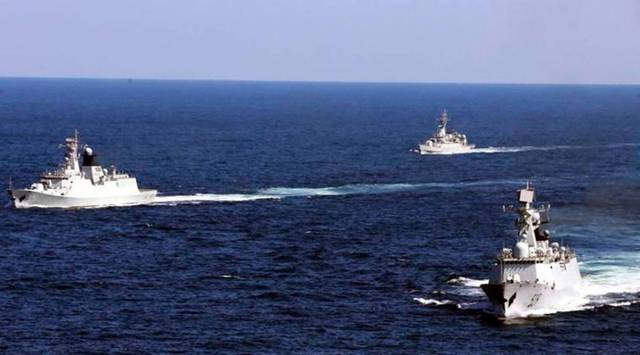- India
- International
Step back from water’s edge
Arun Prakash writes: India's response to presence of Chinese military vessels in Indian Ocean needs to be more calibrated
 Reports that Sri Lanka has asked for a delay in the Chinese ship’s arrival may temporarily calm the waters and provide respite for a dispassionate examination of the issue through legal, military and diplomatic lenses. (Representational/AP)
Reports that Sri Lanka has asked for a delay in the Chinese ship’s arrival may temporarily calm the waters and provide respite for a dispassionate examination of the issue through legal, military and diplomatic lenses. (Representational/AP)Reports about the impending visit of a Chinese “spy ship”, Yuan Wang-5, to the Sri Lankan port of Hambantota, created a major flutter in the Indian media. Citing the ship’s “lethal capabilities” and “aerial reach of more than 750 km”, fears have been expressed that “atomic research centres within Indian borders could be snooped upon”. Reflecting concerns at the “highest levels” in New Delhi, social media fired unkind comments about India’s emergency economic assistance to an “ungrateful Sri Lanka”.
Reports that Sri Lanka has asked for a delay in the Chinese ship’s arrival may temporarily calm the waters and provide respite for a dispassionate examination of the issue through legal, military and diplomatic lenses. But before that a quick look at the ship’s provenance is in order. Yuan Wang is the generic name given to a flotilla of seven to eight ships belonging to the Chinese PLA’s Strategic Support Force. These large “survey/research” vessels carry optical, laser, passive-radio and radar devices whose large dish-antennae enable tracking of ballistic-missile trajectories, monitoring of satellite and space vehicle launches, and gathering of technical intelligence.
From the legal perspective, the 1982 UN Convention for Law of the Seas permits unfettered freedom of navigation on the high seas and a foreign warship has as much right to be in the Indian Ocean as a similar Indian vessel would in the South China Sea. Even in the 200-mile exclusive economic zone, there exists the conditional right of “innocent passage” for all vessels, including warships. Entry into foreign ports, especially for warships, has to be with prior consent. But even in wartime, the 1907 Hague Convention permits entry for warships of belligerents into neutral ports for limited durations. Given its cordial diplomatic relations, and its economic dependence on China, there could be no plausible reason for Sri Lanka to deny entry for Yuan Wang 5, especially into Hambantota on which China has a 99-year lease.
Viewed from the security angle, the presence of a research ship like the Yuan Wang 5, bristling with multi-spectral surveillance and eavesdropping devices, in India’s vicinity, certainly calls for vigilance and caution. However, in this age of transparency, regular electronic “snooping” by ships, aircraft and satellites — both friendly and hostile — happens all the time. Our armed forces and other agencies are aware of this, and precautionary policies and procedures relating to electronic emissions and missile-firing trials are in place. One can also be sure that the position and movements of Yuan Wang 5, as long as she is in our waters, will be closely followed by the Indian Navy’s maritime domain awareness matrix.
Coming to the diplomatic aspect, observers have harked back to the September 2014 visit of a PLA Navy’s (PLAN) Type-039, a diesel submarine which had docked in Colombo, to be followed a few weeks later by a port-call by a Type-091 nuclear-powered attack submarine. The Sri Lankan government had then brushed aside India’s concerns describing the ship-visits as “usual practice”, while a Chinese communiqué had (with unintended flippancy) stated that the submarines were en route to the Gulf of Aden “for anti-piracy duty”.

Some in India have viewed the forthcoming visit of the Chinese “spy ship” to Hambantota as an infringement of the 1987 Indo-Sri Lankan Accord, which calls upon the two countries not to allow their respective territories to be used for “activities prejudicial to each other’s unity, integrity and security”. However, Colombo has often acknowledged that the security and economic interests of both India and Sri Lanka are inextricably interlinked and any deliberate actions that harm Indian interests will eventually rebound on it.
As we await further developments, there is a need to reflect on Sri Lanka’s current political meltdown and dire economic crisis. Given its geographic proximity and ethnic connection, India cannot allow Sri Lanka to sink. New Delhi has already rendered substantial help, but with the best of intentions, India has neither the economic wherewithal nor political capital to pull Sri Lanka out of the abyss. Therefore, apart from the IMF, China will have to lend a hand for Sri Lanka’s economic recovery. For this to happen, Colombo will need to kowtow to Beijing, and India must show diplomatic forbearance. Some other issues, germane to this discussion, need to be noted by India’s decision-makers.
First, India must face the reality that with its 350-warship strong (and growing) battle force having overtaken the US Navy, China has achieved its ambition of becoming a “maritime Great Power”. China’s 2019 Defence White Paper charges the PLA navy with the responsibility of safeguarding Xi Jinping’s prized Maritime Silk Road that spans the Indo-Pacific and includes the China-Pakistan economic corridor. The string of ports, created by China, in India’s neighbourhood, are meant to undergird this endeavour.
Thus, until India can bolster its economic and maritime power and, perhaps, enforce its version of a “Monroe Doctrine,” it will have to live with frequent PLAN presence in the Indian Ocean. We must also prepare for the day when the Taiwan situation permits China to station an aircraft-carrier battle-group in our waters.
The second issue that deserves our attention is the intense activity of China’s space programme, which has planned 50 space-launches for 2022. In mid-April, three Chinese astronauts returned to earth, after spending six months aboard their 11-year-old space-station. In early June 2022, another spacecraft took a team of three astronauts to dock with the under-construction Tiangong-3 space station. During such space activity, survey/research ships need to be positioned for control and tracking as well as rescue tasks in dispersed oceanic locations ranging from mid-Pacific and south Indian Ocean to the coast of Africa. While the actual mission of Yuan Wang 5 is not known, it is just possible that she may be on such a legitimate space-related assignment.
Finally, let us remember that ISRO also has an ambitious manned space programme underway and DRDO is, or will be, undertaking test flights of its Agni series of inter-continental ballistic missiles over distant oceanic stretches. India, too, will seek to deploy “research” vessels in distant waters/ports in days ahead.
The writer is a retired chief of naval staff
40 Years Ago
EXPRESS OPINION
More Explained
Apr 19: Latest News
- 01
- 02
- 03
- 04
- 05









































